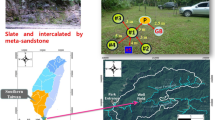Abstract
A three-dimensional (3-D) discrete fracture network (DFN) geo-descriptive model is developed for water conducting features (WCFs) in the sedimentary formations of Horonobe underground research laboratory (URL) in Japan. Fracturing and faulting system in/around the URL area, which is the main investigation area of the Horonobe URL project, is characterized by taking into account borehole geophysical logging data, regional geologic/structural data, and fracture/fault data (orientation, intensity, size) obtained from the surface-based investigations. Volumetric fracture intensity potential is estimated by the correlation and the multi-linear regression analysis of observed data, and is used as one of controls for 3-D DFN model. A regional scale 3-D geo-descriptive DFN model is constructed based on the analyzed fracturing system identified for the WCFs. The current 3-D geo-descriptive model could be utilized explicitly to derive performance assessment (PA) parameters for the hypothetical repository of the high-level radioactive wastes in Japan, and to assist optimization of the safe repository design.
Similar content being viewed by others
References
K. Hatanaka, H. Umeki and H. Osawa, Third AMIGO Workshop Proceedings, OECD/NEA, 134–153 (2009)
D. Lim et al., Mat. Res. Soc. Symp. Proc.1107, 567–575 (2008)
K. Ota, et al., JAEA Research 2007–044 (2007). (in Japanese)
W. Dershowitz et al., “FracMan Interactive Discrete Feature Data Analysis, Geometric Modeling, and Exploration Simulation”, User Doc., Ver. 2.6, Golder Associates (1998).
X. Wang, Ph.D. Thesis, Virginia Polytechnic Institute and State University (2005).
W. Dershowitz, Ph.D. Thesis, MIT(1984).
R.J. Lisle, AAPG Bulletin, 78 (12), 1811–1819 (1994).
R.D. Terzaghi, Geotechnique, 15, 287–304 (1965).
P.R. La Pointe and J. Hermanson, SKB R-05-28 (2006).
E. Ishii, et al., Journal of Structural Geology, doi:10.1016/j.jsg.2009.10.012 (2009).
C. Doughty, C.F. Tsang, K. Hatanaka, S. Yabuuchi and H. Kurikami, Water Resour. Res., 44, W08403, doi:10.1029/2007WR006441 (2008).
H. Funaki, E. Ishii and T. Tokiwa, Jour. Japan Soc. Eng. Geol., 50, 238–247 (2009).
W. Dershowitz et al., 39th US Rock Mech. Symp., Cambridge, MA,VGE:Essen, 887–891 (2003).
Author information
Authors and Affiliations
Rights and permissions
About this article
Cite this article
Hatanaka, K., Lim, DH. & Ishii, E. Geo-Descriptive Modeling of Water Conducting Features Characterized in Sedimentary Formations in Horonobe Area of Japan. MRS Online Proceedings Library 1265, 604 (2010). https://doi.org/10.1557/PROC-1265-AA06-04
Received:
Accepted:
Published:
DOI: https://doi.org/10.1557/PROC-1265-AA06-04




